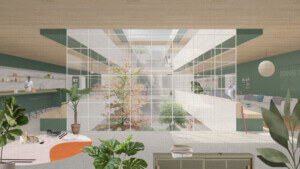With the scent of wet St. Louis clay wafting through the air, the Data Clay Symposium kicked off at CCA last weekend. Hosted by the Architecture & Fine Arts Divisions at CCA, the Graham Foundation for Advanced Studies in the Fine Arts, and the CCA Digital Craft Lab, the event joined architects, artists, designers, makers, critics and creators to discuss and display their latest syncretic experiments and the possibilities of the seemingly disparate mediums of data (i.e. computation) and clay.
Moderated and curated by Joshua G. Stein and Del Harrow, and following on the heels of an exhibition on view at the San Francisco’s Museum of Craft & Design, the symposium started with a talk by Future Cities Lab co-founder Jason Johnson and his Creative Architecture Machines research group at CCA, exhibiting student work that integrates robotics, interactivity, coding, and clay extrusions manifested in real time.
Ron Rael of UC Berkeley and Emerging Objects followed with his research into Earth Architecture and the ancient strategies of clay building. Walking the line between passive building and high-tech computational techniques with his experiments on evaporative cooling bricks, Rael demonstrated the potential of the ancient and the modern coming together in a coherent and cogent architecture of today.
Jenny Sabin of Cornell University and Jenny Sabin Studio presented work connecting biology, coding, and material systems that have fostered her experimental practice, which works at the intersection of rapid-prototyping, scientific exploration, and ceramics. With a BFA in Ceramics and a Masters of Architecture, Sabin has been able to integrate and develop a unique space for a practice that radically combines the digital and the analogue.
Andy Brayman, a studio potter of the Kansas City–based Matter Factory, presented his unique take on traditional ceramics and data by showing off his knowledge of code and software platforms through his open-sourced self-education and research developments.
The morning session came to a close with work presented by UC Berkeley PhD student Laura Devendorf and her playful syntheses of art practice, technology, and research. Her experiments, work at the intersections of a diverse set of disciplines, presenting innovative promise for the “maker” field.
The afternoon featured a keynote by Dries Verbruggen from Antwerp design studio Unfold. Verbruggen’s talk traced the history of digital design, then referenced his book Printing Things, which investigates the myriad techniques and processes of printing. He touched on notions of copying, iteration, and the physics of the physical world gone digital. One of the most intriguing projects of the symposium, on display at the Museum of Craft and Design, is Unfold’s recreation of a potter’s throwing wheel in digital form, which can be changed through your hands’ interaction.
Bobby Tigerman, associate curator of decorate arts and design at LACMA, followed, channeled remotely from Los Angeles, with a historical look at issues of technology and the hand-made, ending with a note that digital craft is on the rise and has prompted stimulating debate and connected cultures worldwide. From the History of Art and Architecture department at UC Santa Barabara, Assistant Professor Jenni Sorkin expounded on the nature of open source, and the hotly-debated realm of ownership and originality in object-hood. Wrapping up the Symposium was Stephanie Syjuco, a sculptor and Assistant Professor in the Ceramics department at UC Berkeley. She glided through her own work, focused on clay, data, and large scale installations, synthesizing traditional ceramic techniques and digital software such as Cinema 4D. Ending the day was an engaging debate revolving around disciplinary identity, scales and modes of production, the quality and quantity of education, and the ability of the arts, architecture, and design to make a real difference in the world today.










